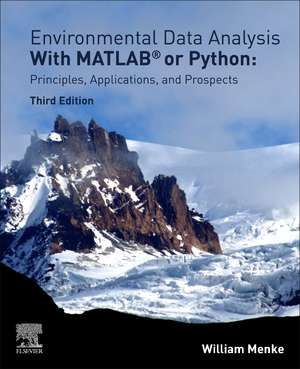Environmental Data Analysis with MatLab or Python: Principles, Applications, and Prospects
Autor William Menkeen Limba Engleză Paperback – 18 aug 2022
Significant content in Environmental Data Analysis with MATLAB, Third Edition is devoted to teaching how the programs can be effectively used in an environmental data analysis setting. This new edition offers chapters that can both be used as self-contained resources or as a step-by-step guide for students, and is supplemented with data and scripts to demonstrate relevant use cases.
- Provides a clear learning path for researchers and students using data analysis techniques which build upon one another, choosing the right order of presentation to substantially aid the reader in learning material
- Includes crib sheets to summarize the most important data analysis techniques, results, procedures, and formulas and worked examples to demonstrate techniques
- Uses real-world environmental examples and case studies formulated using the readily-available software environment in both MATLAB® and Python
- Completely updated and expanded to include coverage of Python and reorganized for better navigability
- Includes access to both an instructor site with exemplary lectures and solutions to problems and a supplementary site with MATLAB LiveScripts and Python Notebooks
Preț: 544.87 lei
Preț vechi: 707.81 lei
-23% Nou
Puncte Express: 817
Preț estimativ în valută:
104.27€ • 108.46$ • 86.08£
104.27€ • 108.46$ • 86.08£
Carte tipărită la comandă
Livrare economică 08-22 aprilie
Livrare express 08-14 martie pentru 78.42 lei
Preluare comenzi: 021 569.72.76
Specificații
ISBN-13: 9780323955768
ISBN-10: 0323955762
Pagini: 466
Dimensiuni: 191 x 235 x 29 mm
Greutate: 0.79 kg
Ediția:3
Editura: ELSEVIER SCIENCE
ISBN-10: 0323955762
Pagini: 466
Dimensiuni: 191 x 235 x 29 mm
Greutate: 0.79 kg
Ediția:3
Editura: ELSEVIER SCIENCE
Public țintă
Researchers and students in upper-level undergraduate or graduate courses in environmental data.Cuprins
1. Data Analysis with MATLAB or Python
2. Systematic explorations of a new dataset
3. Modeling observational noise with random variables
4. Linear models as the foundation of data analysis
5. Least squares with prior information
6. Detecting periodicities with Fourier analysis
7. Modeling time-dependent behavior with filters
8. Undirected data analysis using factors, empirical orthogonal functions and clusters
9. Detecting and understanding correlations among data
10. Interpolation, Gaussian Process Regression and Kriging
11. Approximate methods, including linearization and artificial neural networks
12. Assessing the significance of results
2. Systematic explorations of a new dataset
3. Modeling observational noise with random variables
4. Linear models as the foundation of data analysis
5. Least squares with prior information
6. Detecting periodicities with Fourier analysis
7. Modeling time-dependent behavior with filters
8. Undirected data analysis using factors, empirical orthogonal functions and clusters
9. Detecting and understanding correlations among data
10. Interpolation, Gaussian Process Regression and Kriging
11. Approximate methods, including linearization and artificial neural networks
12. Assessing the significance of results
